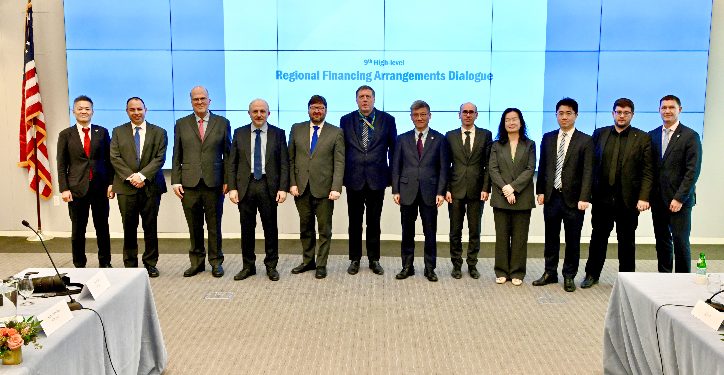- A decade on, IMF–RFA pact looks to harden the global safety net
The International Monetary Fund and the world’s Regional Financing Arrangements (RFAs) marked ten years of structured cooperation on Tuesday, using their 10th Annual High-Level Dialogue to signal a more tightly stitched Global Financial Safety Net (GFSN) for a markedly tougher macro environment.
Since the dialogue’s launch in 2016, global growth has slowed, debt loads have climbed, and policy space has narrowed. Layered on top are secular forces, digitalisation and artificial intelligence, demographic shifts, and climate transition that amplify cross-border spillovers even as many sovereigns face weaker medium-term prospects. The message in Washington: the two-tier safety net must be quicker, clearer, and better coordinated.
IMF Managing Director Kristalina Georgieva opened proceedings by reasserting the Fund’s central role while emphasising interdependence. The IMF and RFAs, she argued, share responsibility “to help safeguard the economic stability of member countries, promote crisis prevention, and provide a more effective shield against crises.” Her call lands as several emerging markets juggle capital-flow volatility with thinner reserves and rising refinancing needs.
Pablo Hernández de Cos, General Manager of the Bank for International Settlements, used the keynote to spotlight the plumbing of crisis response, international reserves and central-bank swap lines. The effectiveness of those lines, he suggested, hinges on credibility and clarity: who gets access, on what terms, and how rapidly. Behind closed doors, participants also reviewed fresh IMF staff work assessing the GFSN’s performance and mapping gaps where overlapping mandates can blur accountability or slow disbursement.
The roster underscored the system’s diversity—from the Arab Monetary Fund and ASEAN+3’s Chiang Mai Initiative Multilateralisation to the BRICS Contingent Reserve Arrangement, the Eurasian Fund for Stabilization and Development, the European Commission/ESM, and Latin America’s FLAR. While each differs in governance and firepower, they collectively represent the first responders when shocks are regional in nature but global in impact.
Why this matters for Ghana and Sub-Saharan Africa
- Speed and sequencing: Clearer protocols between the IMF and RFAs can shorten the time from request to relief, which is critical for countries managing external shocks and tight budgets.
- Crisis prevention: Stronger surveillance and swap-line architecture can steady capital flows and foreign-exchange markets, complementing domestic reform.
- Climate and digital transitions: With climate finance and digital-era risks rising, a more “fit-for-purpose” safety net can backstop investment while cushioning volatility.
- Policy credibility: Joint signalling by the IMF and RFAs can crowd in private capital when sovereigns pursue reforms under Fund programmes.
Tuesday’s statement leaned into multilateralism at a moment when fragmentation is fashionable. The institutions pledged “cooperation, solidarity, and readiness to meet the challenges of tomorrow” and confirmed two next steps: the 10th Joint RFA Research Seminar in Abu Dhabi in the first half of 2026, and the 11th High-Level Dialogue on the margins of the IMF/World Bank Annual Meetings in Bangkok in October 2026.
In a world of slower growth and fatter tail risks, the cost of coordination failure is rising. The dividend from a well-oiled safety net, a quicker line of defence, stronger reform anchors, and more credible market signals could be largest where buffers are becoming even thinner.








